


Redox and coordination chemistry of copper and sulfite
Although copper(II) compounds and sulfites are very common, the reaction between the two is not commonly studied. This webpage shows that the chemistry of copper(II), combined with sulfite, bisulfite or sulphur dioxide is not simple at all. The resulting behavior strongly depends on the pH of the used solutions.
A series of experiments is performed, in which solutions of copper sulfate are mixed with solutions of sulfites at different pH's. It is shown that at both extreme ends of the pH-scale no redox reaction occurs, while at intermediate pH very interesting reactions occur.
![]()
![]() Required
chemicals:
Required
chemicals:
-
copper sulfate
-
dilute sulphuric acid (2 M solution)
-
sodium hydroxide
-
sodium sulfite
-
sodium metabisulfite
![]() Required
equipment:
Required
equipment:
-
test tubes
-
heater for heating the test tubes
![]() Safety:
Safety:
-
Sodium hydroxide is very corrosive to the skin and especially the eyes. Avoid contact with the eyes at any cost! When the solution comes in contact with the skin, then rinse with water, until the slippery feeling is gone.
-
Dilute sulphuric acid is corrosive.
-
In some of the experiments some sulphur dioxide is formed. This is a very pungent gas and inhalation of this gas should be avoided. Only small amounts are formed, so this is not a serious risk, but for some people the gas may introduce some inconvenience.
-
Copper sulfate is moderately toxic for humans.
![]() Disposal:
Disposal:
-
Copper salts are rather toxic for aquatic life (plant life and microbial life) and hence the waste should not be flushed down the drain. Bring it to a municipal waste processing facility.
![]()
Reactions at low pH
In this experiment, it is shown that at low pH no redox reaction occurs.
![]() Take a spatula full of sodium metabisulfite and add this to a few ml of dilute
sulphuric acid. The solid dissolves and small amounts of sulphur dioxide gas are
produced. Most of the sulphur dioxide, however, remains in solution. This gas
dissolves in water quite well.
Take a spatula full of sodium metabisulfite and add this to a few ml of dilute
sulphuric acid. The solid dissolves and small amounts of sulphur dioxide gas are
produced. Most of the sulphur dioxide, however, remains in solution. This gas
dissolves in water quite well.
![]() Take a
small amount of copper sulfate and dissolve this in water and add this solution
to the acidic solution of sodium metabisulfite.
Take a
small amount of copper sulfate and dissolve this in water and add this solution
to the acidic solution of sodium metabisulfite.
When this experiment is done, then after mixing of both solutions, a light blue solution is obtained. Nothing special happens, the blue color of the copper sulfate simply is diluted. On boiling, the solution remains light blue. Quite some sulphur dioxide escapes from the hot liquid (bubbling and smell!), but the color of the solution does not change.
So, it can be concluded that at very low pH (around 0) there is no redox reaction at all, even at quite high concentration of sulphur dioxide, derived from the added sulfite.
![]()
Reactions at medium pH, at acidic side of scale
At weakly acidic pH around 4, the behavior of copper and sulfite is quite different. Such solutions can conveniently be produced by dissolving sodium metabisulfite or sodium bisulfite in water. They can also be prepared by dissolving sodium sodium sulfite and carefully adding the correct amount of sulphuric acid to the solution, such that for half of the sulfite, one molecule of sulphuric acid is added. Such solutions have a pH, close to 4.
![]() Dissolve a spatula full of sodium metabisulfite in water, or if this is not
available, then prepare an acidic solution from sodium sulfite and dilute
sulphuric acid, such that the pH is near 4. This solution is colorless and has a
faint smell of sulphur dioxide.
Dissolve a spatula full of sodium metabisulfite in water, or if this is not
available, then prepare an acidic solution from sodium sulfite and dilute
sulphuric acid, such that the pH is near 4. This solution is colorless and has a
faint smell of sulphur dioxide.
![]() Take a
small amount of copper sulfate and dissolve this in water.
Take a
small amount of copper sulfate and dissolve this in water.
The resulting two solutions are shown below. In the experiment, a fairly large excess amount of metabisulfite was used, relative to the amount of copper sulfate.
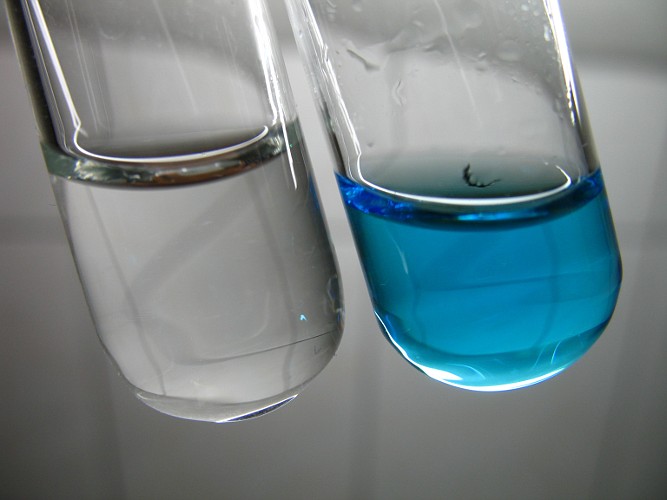
When these two solutions are mixed, then immediately, a color change occurs. The liquid becomes bright green and it remains so when put aside for a few minutes. After heating, however, the color fairly quickly changes. The green color shifts towards yellow/brown. The pictures below show the result of mixing both liquids, immediately after mixing, and heating for a minute or so, such that the liquid is hot to the hand, but not boiling hot.
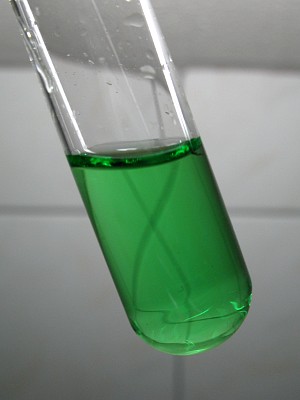
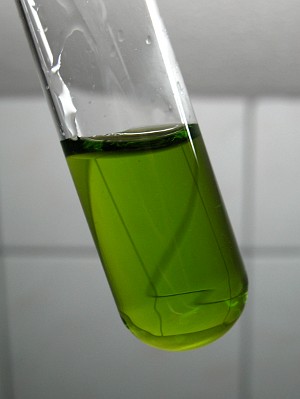
When heating is continued, then a dark red precipitate is formed, which quickly settles at the bottom. When the liquid is boiled for several minutes, then finally all of the green color disappears and a nearly colorless liquid is obtained with a brick red solid in it. The following pictures show the formation of the red precipitate and the situation after boiling for a few minutes and allowing the precipitate settle at the bottom of the test tube.
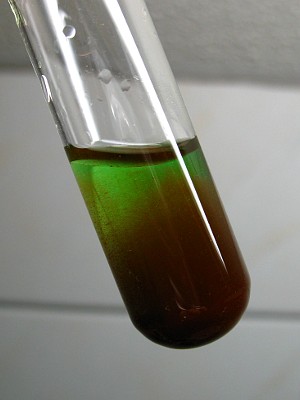
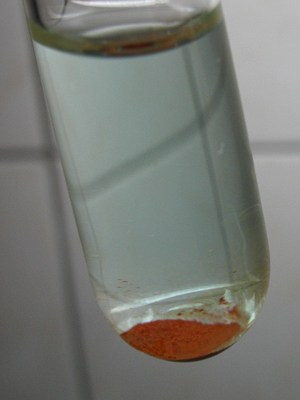
Another experiment was done, but in this experiment the liquid was not heated after mixing. It was set aside for a few days. In this situation, larger, nearly black crystals are formed, which settle at the bottom of the test tube. Most likely this is the same compound as formed in the experiment, described above, but it looks darker due to the larger particle size. Even after two days of waiting, the liquid above the crystals is not as light as the liquid, obtained after a few minutes of boiling.
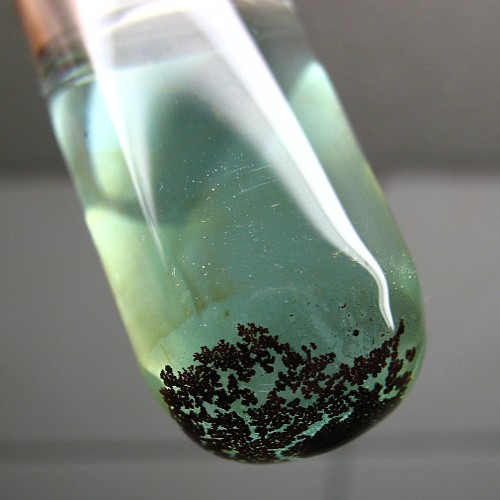
The brick red solid compound, produced in this experiment is the so-called Chevreul's salt. It is a mixed valence copper(I)/copper(II) complex with net formula CuSO3·Cu2SO3·H2O. This compound has a remarkably complex crystal structure, which is described in the linked article.
![]()
Reactions at medium pH, at alkaline side of scale
A similar set of experiments was done, but now at the other side of the neutral point of the pH scale. A moderately concentrated solution of sodium sulfite has a pH around 10. This is weakly alkaline.
![]() Dissolve a spatula full of sodium sulfite in water. This solution is colorless
and is weakly alkaline. It is totally odorless.
Dissolve a spatula full of sodium sulfite in water. This solution is colorless
and is weakly alkaline. It is totally odorless.
![]() Take a
small amount of copper sulfate and dissolve this in water.
Take a
small amount of copper sulfate and dissolve this in water.
Again, it is assured that there is a fairly large excess amount of sulfite, relative to the copper.
When the solution of copper sulfate comes in contact with the solution of sodium sulfite, then immediately a slimy dirty green/yellow/brown precipitate is formed. After shaking, this precipitate becomes somewhat more yellow.
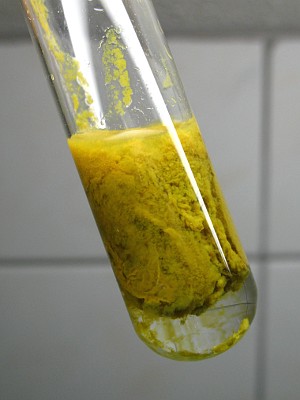
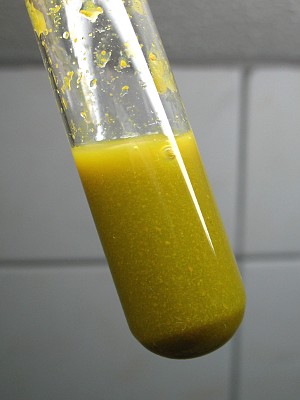
When this liquid is heated and boiled for a while, then the dirty yellow precipitate dissolves. The liquid becomes yellow and opalescent:
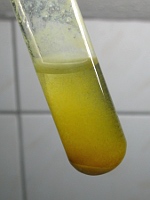
The dissolving of the precipitate continues on heating, until finally a colorless solution is obtained. This colorless solution is air-sensitive. It reacts with oxygen from the air and becomes covered by a green layer. The following pictures show a freshly prepared colorless solution obtained in this way, and a solution which is allowed to stand in contact with air for a few tens of minutes (in another experiment).
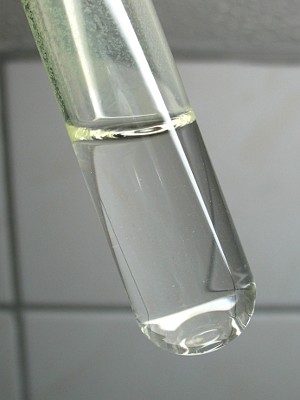
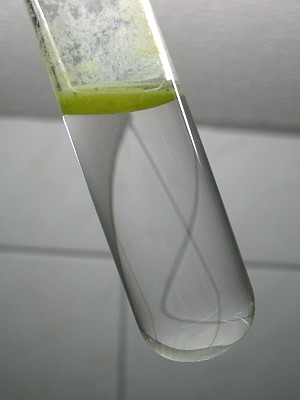
An interesting phenomenon occurs when the pH is raised strongly in the colorless solution, by adding some sodium hydroxide. When this is done, then immediately a bright yellow precipitate is produced. The following picture shows the result of adding a few granules of solid NaOH to the colorless liquid in the test tube as shown in the right picture. The green layer breaks apart in a few large blobs, but it does not dissolve nor does its color change. The liquid itself is filled with a very fine yellow/orange precipitate.
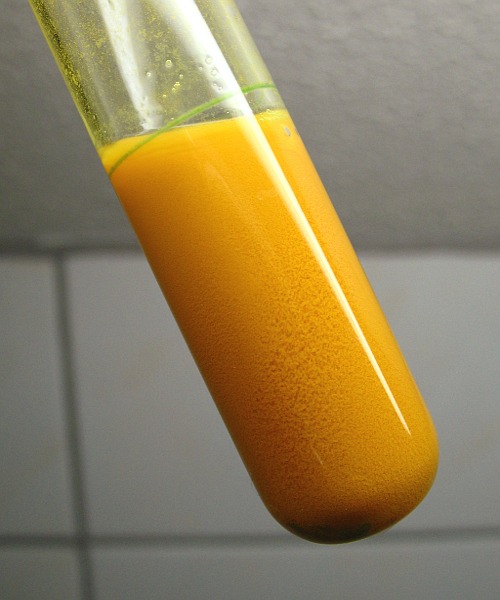
The yellow/orange solid most likely is hydrous copper(I) oxide, which quickly precipitates from solution, due to its very low solubility in water.
![]()
Reactions at high pH
The previous experiment suggests that at very high pH (around 14) there will be a fast reaction in which copper(I) oxide is formed when copper(II) is exposed to sulfite. The following experiment was done to test behavior at high pH.
![]() Dissolve a spatula full of sodium sulfite together with a
similar amount of sodium hydroxide in a few ml of water. This solution is colorless
and is strongly alkaline.
Dissolve a spatula full of sodium sulfite together with a
similar amount of sodium hydroxide in a few ml of water. This solution is colorless
and is strongly alkaline.
![]() Take a
small amount of copper sulfate and dissolve this in water.
Take a
small amount of copper sulfate and dissolve this in water.
When the liquids are mixed, then a bright blue precipitate is formed, which almost certainly is plain copper(II) hydroxide. A small amount of yellow/green precipitate is formed, but this is only due to lower pH of mixed liquids on the glass wall of the test tube. On shaking, the precipitate remains blue. When the precipitate is heated to boiling, then it slowly turns black. This is the well known decomposition of copper(II) hydroxide to copper(II) oxide and water. No reduction of copper(II) to copper(I) occurs.
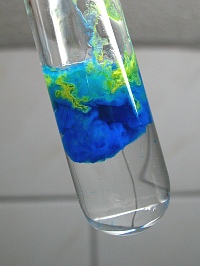
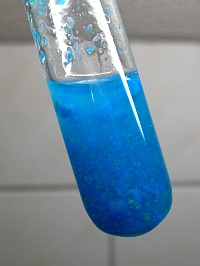
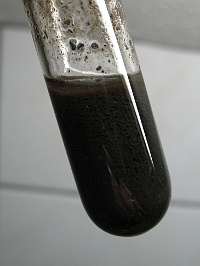
So, at very high pH, no redox reaction occurs. When copper sulfate, sodium sulfite and sodium hydroxide are mixed, then the order of adding the chemicals is important. If the copper sulfate and sodium sulfite are mixed before adding the sodium hydroxide, then the yellow hydrous copper(I) oxide is produced, otherwise the blue copper(II) hydroxide is produced.
![]()
Discussion of results
The great differences in behavior for reaction between copper(II) and sulfite can be explained by means of two different properties, which both depend on pH.
- Coordination of sulfite to copper(II) ions. At higher pH, there is more sulfite ion and this assures that there is a higher amount of copper(II) which is attached to sulfite ion. Sulphur dioxide is not capable of reducing copper(II) ions, but sulfite is. This explains why at very low pH there is no redox reaction at all, at weakly acidic pH there is partial reduction and at higher pH there is complete reduction. The copper(II) sulfite acts as an intermediate in the redox reaction. First, sulfite ion is coordinated to copper(II) and then an electron transfer occurs inside this complex.
- Solubility of copper(II) ions. At very high pH, copper(II) is highly insoluble. All copper(II) is precipitated as copper(II) hydroxide or copper(II) oxide and the concentration, available for the redox reaction between copper(II) and sulfite is so low that it hardly occurs anymore.
The first effect explains why no redox reaction occurs at very low pH. The sulfite then is converted to sulphur dioxide, which does not coordinate to copper(II) and hence no redox reaction occurs. The second effect explains why no redox reaction occurs at very high pH. There simply is no soluble copper(II) present in solution, which can coordinate to sulfite ions.
The main redox reaction is the following:
2Cu2+ + SO32– + H2O → 2Cu+ + SO42– + H+
This reaction, however, cannot occur in this simplified form, because copper(I) ions are not stable in aqueous solution. A suitable coordinating agent is needed to let this reaction proceed. This suitable agent is the sulfite ion again. At somewhat acidic conditions, Chevreul's salt is produced, in which the copper(I) ions are coordinated to sulfite ions and form a double salt with copper(II) sulfite. At higher pH all of the copper(II) is reduced and all of it remains in solution as a colorless copper(I) sulfito complex.
When sodium hydroxide is added to this sulfito complex of copper(I), then the highly insoluble hydrous copper(I) oxide is formed. Apparently the sulfito complex of copper(I) still allows exchange of sulfite ligands with other ligands and this causes exchange with hydroxide ions, which, once attached to the copper(I) ions, do not easily disconnect again and quickly all sulfito ligands are replaced by hydroxide.